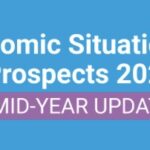The escalation in the conflict between Israel and Iran, marked by Israeli strikes on Iranian military and nuclear facilities and the reported deaths of high-profile Iranian military figures, is sending ripples of concern across South Asia. The region, heavily dependent on Middle Eastern oil, trade routes, and remittances, faces a challenging economic outlook if tensions persist.
Soon after the strikes by Israel, US Secretary of State Marco Rubio issued a statement confirming that the United States is not part of the strikes against Iran. He called it a “unilateral action” by Israel.
“Tonight, Israel took unilateral action against Iran. We are not involved in strikes against Iran and our top priority is protecting American forces in the region. Israel advised us that they believe this action was necessary for its self-defense,” said Secretary Rubio. “President Trump and the Administration have taken all necessary steps to protect our forces and remain in close contact with our regional partners. Let me be clear: Iran should not target U.S. interests or personnel.”
US President Donald Trump in his social media post noted, “I gave Iran chance after chance to make a deal…”
Senior Vice President at Anand Rathi Global Finance, Naveen Vyas, underscored India’s vulnerability, stating, “Since India relies on imports for over 80 percent of its crude oil needs, a conflict between Iran and Israel could lead to a spike in Brent crude prices.”
Iran, holding approximately 9 percent of the world’s oil reserves, could trigger significant disruptions. Indian sectors such as oil marketing companies (BPCL, HPCL, IOC), paints (Asian Paints, Berger Paints), as well as the automobile and cement industries, could face “demand slowdown or margin pressure if tensions escalate and persist for more than 3–6 months, particularly if Brent crude prices rise above the USD 82–85 per barrel mark.”
Senior Middle East and North Africa Economist at Capital Economics, James Swanston, noted the immediate impact of the overnight strikes. “The overnight strikes by Israel on Iran mark a major escalation in the conflict in the region and, with the oil market tighter than it was a few months ago, the risks to oil prices look more balanced than we’d previously thought,” he said.
While oil prices initially jumped by 13 percent overnight, nearing $80 per barrel before unwinding to around $73, the critical question remains Iran’s response. Swanston highlighted that previous Iranian responses during tit-for-tat strikes were calibrated to avoid escalation, but comments from Iran’s Supreme Leader suggest a more aggressive stance is a key risk.
Crucially, the analyst pointed out that the current situation differs from previous flare-ups due to the dwindling spare capacity within OPEC+. This buffer, which previously insulated the oil market, is already being drawn down, making the market more susceptible to volatility.
South Asian Implications: A Deeper Dive
The reverberations of this conflict extend beyond India, impacting the entire South Asian region. Economists are highlighting several key areas of concern:
Oil Price Surges and Inflation: South Asian nations, including India, Pakistan, Bangladesh, and Sri Lanka, import over 80 percent of their crude oil from the Middle East. Any disruption in the Strait of Hormuz, through which 20 percent of global oil flows, could push Brent crude prices significantly higher.
Sakshi Gupta of HDFC Bank in India warned, “South Asia’s energy dependence makes it vulnerable to oil price shocks. A prolonged Israel-Iran conflict could push inflation higher, widen trade deficits, and delay monetary easing across the region.” For India, a $10 per barrel increase could widen the current account deficit by 0.3-0.4 percent of GDP and push consumer price inflation up by 20-30 basis points, potentially exceeding 6 percent in 2024. Weaker fiscal buffers in Pakistan and Sri Lanka could lead to severe balance-of-payments pressures.
Trade and Shipping Disruptions: The Red Sea, a vital conduit for South Asia’s substantial trade with Europe, Africa, and West Asia, is already facing threats from Iran-backed Houthi attacks. Increased freight costs and insurance premiums are directly impacting exports like textiles from Bangladesh and gems and pharmaceuticals from India.
Ajay Srivastava of Global Trade Research Initiative (GTRI) in India cautioned, “South Asia’s trade routes are at risk. Projects like IMEC and Chabahar are critical for regional growth but could stall if the conflict widens.” The India-Middle East-Europe Economic Corridor (IMEC) and the Chabahar Port, crucial for India and Afghanistan, face potential delays, undermining regional connectivity efforts. Pakistan’s Gwadar Port, part of the China-Pakistan Economic Corridor, could also see reduced activity.
Remittances and Workforce Risks: The Gulf region is home to over 15 million South Asian workers, who collectively send home an estimated $100 billion annually in remittances. An escalation in the conflict could disrupt these vital financial flows, particularly for Pakistan ($30 billion) and Bangladesh ($22 billion). Safety concerns for workers in countries like Israel (e.g., 97,000 Indians, 18,000 Nepalese) and Iran may necessitate evacuations, placing a significant strain on government resources. Sri Lanka, still recovering from its 2022 economic crisis, is particularly vulnerable to any decline in remittances.
Market Volatility and Investment: South Asian stock markets, led by India’s Sensex and Nifty, have already experienced volatility since October 2024 due to geopolitical fears. Smaller markets in Pakistan and Bangladesh are even more fragile, possessing limited foreign exchange reserves to counter potential capital outflows. A shift towards safe-haven assets like gold could reduce foreign direct investment (FDI), which is crucial for infrastructure development in nations like Nepal and the Maldives.
Geopolitical and Strategic Challenges: The conflict tests South Asia’s delicate diplomatic balancing act. India maintains crucial ties with both Israel (defense and technology) and Iran (energy and connectivity projects like the Chabahar Port and the International North-South Transport Corridor – INSTC). Pakistan’s traditionally pro-Palestine stance aligns it closer to Iran, potentially risking relations with Gulf allies like Saudi Arabia. Afghanistan, under Taliban rule, faces exacerbated economic isolation due to potential trade disruptions via Chabahar. Regional cooperation bodies like SAARC remain stalled, limiting a collective response to the crisis.
Economists’ Perspectives on Resilience and Risks:
While some economists believe India’s strong forex reserves and macroeconomic fundamentals can cushion short-term shocks, the long-term risks are considerable. Paras Jasrai of India Ratings and Research stated, “There would be some economic impact for India, but, so far, domestic factors have been strong, which has kept the overall outlook strong.” However, NR Bhanumurthy of Madras School of Economics cautioned, “If the war is going to be short term, then no issue, but if it’s prolonged and there is a widening of conflict, it will be a risk. The impact on investments will delay global recovery, and India’s exports may be impacted.”
Shamika Ravi of the Indian School of Business emphasized the disparate impact: “India’s macroeconomic resilience can absorb short-term shocks, but smaller economies like Sri Lanka and Pakistan face acute risks from oil and remittance disruptions.”
Mustafa Pasha of Karachi University, Pakistan, highlighted the dire situation for his country: “Pakistan’s economy, already under IMF scrutiny, could face a crisis if oil prices soar and Gulf remittances dip. The government must diversify energy sources.” Selim Raihan of the University of Dhaka, Bangladesh, echoed concerns for his nation: “Bangladesh’s export-driven economy will suffer from Red Sea disruptions. Higher shipping costs could erode our textile competitiveness.”
The escalating Israel-Iran tensions present South Asia with a complex web of economic challenges, including higher oil prices, trade disruptions, and remittance risks, all of which could amplify inflation and economic volatility. While India may be able to weather some short-term impacts, smaller economies in the region face severe and potentially destabilizing challenges. Regional coordination and astute strategic diplomacy will be paramount in navigating this intensifying crisis.






